

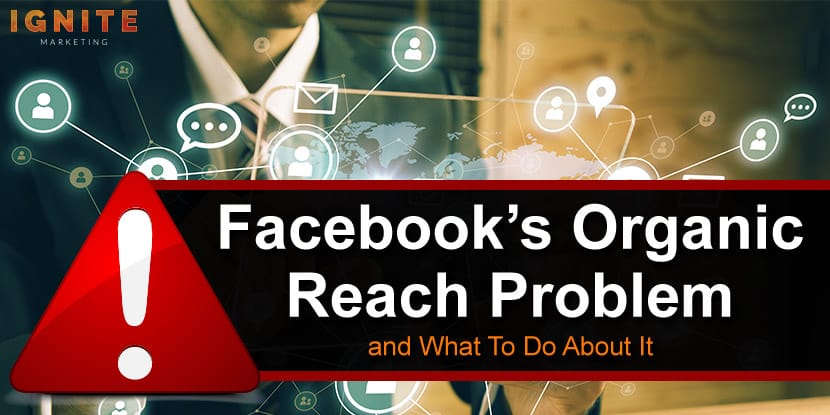
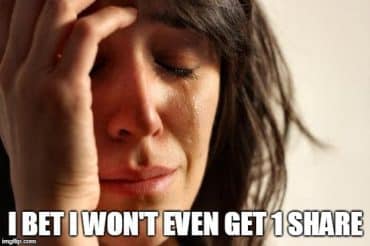 Facebook hates your business.
Facebook hates your business.
At least, that’s the way it appears based on the drastic decline of organic reach over the last few years.
And with the latest onslaught of News Feed announcements (here, here, here, and here), it’s clear the social media goliath intends to get even more ruthless with business page content that’s organically shown to its users.
Hint: it’s probably not yours.
Some are calling it #FacebookZero.
Others are declaring that the Facebook apocalypse has arrived.
But what does it all mean and how do these News Feed algorithm changes impact your business?
Well, let’s first take a look at the Facebook organic reach problem as a whole.
Believe it or not, you’ve been adapting to restricted organic reach since before the royal wedding, Charlie Sheen’s monumental meltdown, and Kim Kardashian’s second divorce. Thanks 2011.
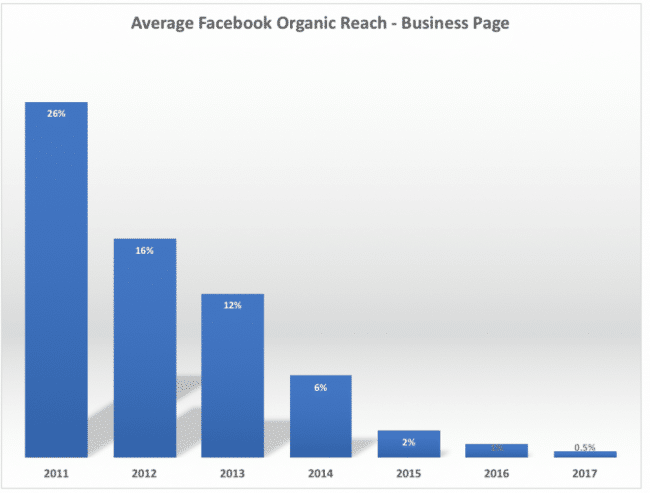 Source: Nielson, Agora Pulse
Source: Nielson, Agora Pulse
According to research by Buzzsumo, Facebook engagement for brands and publishers fell by 20% in the first six months of 2017 alone.
So, why has this been happening?
The reason is two-fold.
The latest announcement has simply reinforced the company’s objective of connecting people by changing the algorithm to prioritize posts from friends, family, and groups over public content. That means businesses, brands, and the media will see even less organic reach unless they have solid strategies in place to create meaningful conversations and interactions between people or they are willing to pay for their content to be seen.
I’m not going to lie. The future for organic reach doesn’t look good.
But does that mean it’s completely fruitless on the organic front and that Pages are essentially worthless?
Nope!
More than a quarter of the world’s population use Facebook on a monthly basis, so establishing and maintaining a presence on the platform is a no-brainer. While things might look different moving forward, Facebook Pages are still extremely valuable for businesses—perhaps now more than ever.
Besides helping you create brand awareness, Page optimization and strategic content are incredibly powerful for driving traffic, growing an email list, generating leads, and boosting sales. In addition, simply owning a Facebook Page is likely to put your business on the first page of Google results any time someone searches for your business name.
Organic reach simply makes these marketing efforts easier and cheaper than if you were pursuing your goals through paid methods. What’s more is that organic reach can increase the effectiveness of your ads while lowering your Cost Per Click and stretching your precious advertising dollars. So no, your Facebook Page isn’t worthless. And yes, you should still aim to build reach organically.
But before we jump into tactics for growing your reach and successfully adjusting to Facebook’s algorithm, let’s consider how Facebook ranks content for its News Feed. This next section might not necessarily be something you appreciate, but it is so crucial to understand. So, bring forth your inner geek and let’s get going.
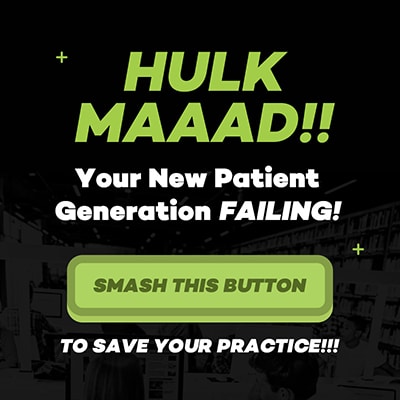 At any given time, you have several thousand pieces of content vying for real estate in your News Feed. These pieces of content are stories you haven’t seen from friends, Pages you follow, and Groups you’ve joined. To help sort through this content and connect you to the stories you care about most, Facebook uses a tool called Ranking.
At any given time, you have several thousand pieces of content vying for real estate in your News Feed. These pieces of content are stories you haven’t seen from friends, Pages you follow, and Groups you’ve joined. To help sort through this content and connect you to the stories you care about most, Facebook uses a tool called Ranking.
According to Adam Mosseri, Head of News Feed, Ranking is a set of algorithms that determine how interested people are in the stories they can see on the platform. Ranking follows a four-step process to make predictions and surface the content you’re most likely to want to see. These steps include:
With all this in mind, how do you make sure Facebook’s News Feed algorithm sees your content as relevant and publishes it to the News Feeds of interested users? And how do you do it while keeping your wallet securely tucked away in your pocket?
Search any marketing blog and you’ll no doubt find something about the importance of producing high-quality content as a way to grow organic reach. When it comes to beating News Feed, though, you’ll want to dive quite a bit deeper than that.
Without further ado, here are seven effective ways to boost your reach for free.
News Feed aims to deliver the right content to the right people at the right time so that they don’t miss stories that matter to them. Therefore, you need to publish the right content for the right people at the right time so that they don’t miss your stories.
Begin with great content.
Want to know who’s going to be penalized most as a result of this algorithm update?
Boring brands.
These businesses will have to deal with disappointingly low organic reach and depressingly high ad prices. Why? Because content that doesn’t resonate with people or evoke action doesn’t generate engagement and it doesn’t get shared.
While you’ll never be able to make every piece of content a viral hit (unless you’re some kind of marketing savant), you should produce content with virality in mind.
Consider this simple video demonstrating a chiropractic adjustment by Dr. Jason Worrall of Active Health Clinic in Sherman Oaks.
 It’s created for a targeted fan base, it includes brief yet descriptive text, it incorporates the popular medium of video, and it blatantly calls people to take an action that would lead to further reach. As an added bonus, the emojis make it playful and fun.
It’s created for a targeted fan base, it includes brief yet descriptive text, it incorporates the popular medium of video, and it blatantly calls people to take an action that would lead to further reach. As an added bonus, the emojis make it playful and fun.
The result is more than 323K views, 908 Reactions, and 259 shares. This post is also cross-posted from Instagram where it earned an additional 19K+ views and a boatload of comments. You might think he must have a massive following to attain those numbers, but the truth is his Facebook Page currently has less than 4,000 fans.
While this kind of result isn’t always typical, there are several things you can do to boost the potential for virality, increase brand exposure, and drive more traffic.
When developing content, think about the people who are likely to share it, as well as their audience. The concept must be a right fit for both or it’s unlikely they’ll pass it along to others. Would your target audience feel comfortable publicizing your post to their friends and family?
Dull and irrelevant headlines will struggle to elicit a click, let alone a “share.” This doesn’t mean you should resort to clickbait headlines (remember, Facebook hates those), but it does mean you should spend time constructing interesting and attention-grabbing headlines that make people want to read or watch your content. Be sure to keep an eye on your Page analytics to see which posts generate the most reach and engagement. You’ll eventually get a feel for what works and what doesn’t.
Sure, entertaining and humorous content tends to generate significant engagement and organic reach, but it can be a tough act to maintain. Helpful content that offers exceptional value is not only easy to create, but it can also have the same viral outcome. If your posts are useful, practical, and worth sharing then people will share them.
Although you want to avoid sensationalism, activating high-arousal emotions can be a highly effective way of triggering engagement and action. Make thought-provoking statements, challenge industry myths, shift the way your audience thinks about a particular topic, do something unexpected, or simply make people laugh. Any time you tap into excitement, awe, amusement, hope, inspiration, joy, love, fear, anger, or disgust, you have a better chance of going viral organically.
By default, the News Feed algorithm will surface content that generates engagement. Since people absorb information in different ways, it’s best to test various formats for your message. For example, let’s say you’re a chiropractor who’s planning to host a ‘Dinner with the Doc.’ Do you let your audience know with a video, Facebook Live video, image, text post, text post with a colored background, a link to a blog post detailing the event, or through another format? The best way to figure this out is to evaluate your Page’s Insights for similar types of messages. Whatever you do, make sure your content is easy to consume. It is social media, after all.
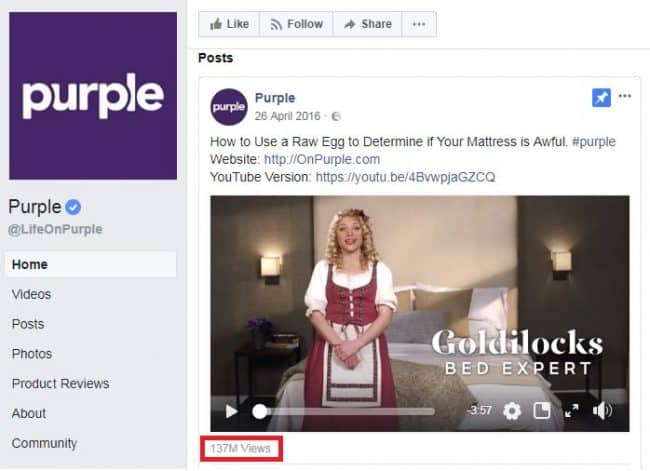 If you’ve seen anything from Purple, you’ll know the kind of whacky and entertaining characters this popular mattress company’s ad agency dreams up on the regular. While you might not want to go this extreme, creating your own appealing and original brand of content can help you increase social sharing and improve brand recognition.
If you’ve seen anything from Purple, you’ll know the kind of whacky and entertaining characters this popular mattress company’s ad agency dreams up on the regular. While you might not want to go this extreme, creating your own appealing and original brand of content can help you increase social sharing and improve brand recognition.
In fact, businesses and brands that have created interesting and funny characters have seen a huge spike in the virality of their content. Special characters might not necessarily fit your brand, but injecting personality into your content while being unique and creative tends to encourage sharing.
Now that you’ve got the content part of your content mix down, what’s next?
Test for optimal posting times.
I’ve spoken about the best Facebook posting times on the blog before. But I’ll say now what I said then: test your posting schedule so that you can optimize the days and times you’ll post for peak participation.
Here are a few experiments you might want to try:
Keep in mind that the longer your post has been available for consumption on News Feed, the less reach it’ll have. To make the most of your Facebook marketing efforts, it’s crucial to have the right content mix: people, post, time.
Did you know that Facebook allows you to target organic posts similar to the way you would target a paid ad?
 This nifty little feature not only helps you reach and engage the right people for a particular message by narrowing down your audience, but it also helps you better understand the interests of people clicking on your posts.
This nifty little feature not only helps you reach and engage the right people for a particular message by narrowing down your audience, but it also helps you better understand the interests of people clicking on your posts.
Let’s say that you’re the owner of a popular local restaurant and you want to host a ladies night. You have a decent size fan base, but your offer isn’t relevant to many of your followers. Instead of publishing a post that might be irrelevant to some of your audience, you can use the targeting tool to ensure your content will only be shown in News Feed to those who will care about it. Limiting your audience this way keeps your content out of irrelevant News Feeds and reduces the risk of your posts being hidden or snoozed—signals that would impact your relevancy score negatively.
How does the tool work?
Step 1: If you don’t see ‘Limit audience by’ in the drop down menu of your Page’s status box, you’ll need to activate it. Click ‘Settings’ in the top right corner of your Page, make sure you’re in the ‘General’ tab, and then find the row labeled ‘News Feed audience and visibility for posts.’ Click ‘Edit’ and then check the box before saving your changes.
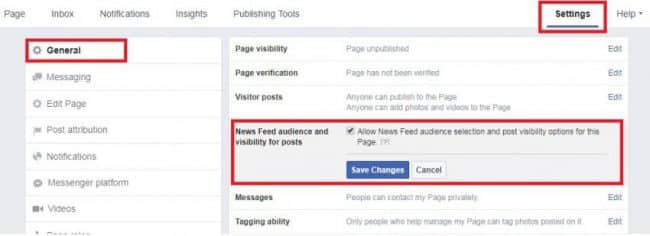
Step 2: Click the drop down menu on your Page’s status box, click ‘Demographics,’ and then click the ‘News Feed targeting’ tab. Select your audience preferences and then click ‘Save.’
 You can now deliver content tailored to your core audience. Be sure to monitor your Page Insights to see whether this simple tactic is moving the needle on your engagement and reach.
You can now deliver content tailored to your core audience. Be sure to monitor your Page Insights to see whether this simple tactic is moving the needle on your engagement and reach.
In Facebook’s blog post announcing the algorithm change, Mosseri made reference to the fact Page posts generating conversation between people will show higher in News Feed and that live videos on average get six times as many interactions as regular videos.
Translation: the News Feed algorithm loves live video content.
However, you shouldn’t count native videos with higher watch time and completion rates out the game just yet.
Videos in general are engaging, and even if people don’t react, like, share, or comment, they still trigger positive signals by watching. Turning on the sound, turning up the volume, making the video full-screen, enabling high-definition, and other actions taken while viewing a video are all taken into account by Facebook’s News Feed algorithm.
Even if organic reach drops further, News Feed will favor video over other types of content. They key is to produce video content worth watching.
If you’re unsure what type of content to post or how to use Facebook Live, be sure to check out my in-depth post on Facebook Live for local businesses. You can also download my free 30 Days of Facebook Live Ideas for Local Business Owners guide.
 When users select ‘See First’ on your Page, your posts will appear at the top of their News Feed. This is especially valuable if you have a highly engaged community because followers who have chosen to prioritize your content are less likely to miss your posts. In addition, encouraging people to activate this option during promotional campaigns such as 30 day challenges can help you keep them engaged and interactive so that your campaign is a success.
When users select ‘See First’ on your Page, your posts will appear at the top of their News Feed. This is especially valuable if you have a highly engaged community because followers who have chosen to prioritize your content are less likely to miss your posts. In addition, encouraging people to activate this option during promotional campaigns such as 30 day challenges can help you keep them engaged and interactive so that your campaign is a success.
All users need to do is make sure they follow your Page if they aren’t already doing so: hover over the ‘Following’ button, and then click ‘See First’ from the dropdown menu. Be sure to position this as a way to stay connected to your awesome content so that they don’t miss important updates and promotions.
By now you should be hyper aware that conversations are critical to making these News Feed algorithm changes work for you. Besides creating content that sparks and inspires meaningful discussion and interaction, it’s crucial to get involved in the comment section yourself.
Oftentimes, businesses will encourage people to comment on their post or share it, but that’s where their side of the interaction ends. They don’t follow up with a response to keep the conversation going and engagement alive. Facebook wants you to build relationships and you’re not going to do that with dialog that leaves little room for building a deeper connection.
Dr. Josh Axe is a pro at being super responsive, keeping the conversation going, and providing additional value to his community.
 So, how do you become a killer conversationalist?
So, how do you become a killer conversationalist?
Gary Vaynerchuck has an innate ability to turn business lessons into interesting stories and he’s richly rewarded with organic reach and engagement.
 Ultimately, you have to get people to trust you. Conversations go a long way in convincing people to like you and persuading them to convert into email subscribers, leads, and eventually customers. These interactions are far more valuable than organic reach, but you can’t have them if people don’t see your posts.
Ultimately, you have to get people to trust you. Conversations go a long way in convincing people to like you and persuading them to convert into email subscribers, leads, and eventually customers. These interactions are far more valuable than organic reach, but you can’t have them if people don’t see your posts.
With Group content ranking higher than Page content in News Feed, Facebook Groups could be just the thing you need to rescue your business from the pitiful state that is organic reach. Any content you share in the Group is bound to show up in the News Feeds of your members, giving you ample opportunity to get the targeted eyeballs of super fans on your content.
How do you entice people to join your Group?
With exclusive content. From contests, Facebook Live webinars on relevant topics, and online classes to special deals, monthly challenges, and expert advice, there’s no reason any business anywhere can’t make use of Groups in a fun and creative way.
How do you create a Group, or more specifically a Group for Pages?
Step 1: Navigate your way to your Facebook Page. You want to make sure your Page and Group are linked, so create a Group from the dropdown menu on the blue Facebook navigation bar. What you want to instead is find the three dots just below your Page’s cover image, click for the dropdown menu, and then select ‘Create group.’
 Step 2: Give your Group a relevant name related to your business or industry and then add people. Facebook allows you to add a personalized note when inviting people to the Group as indicated by the blue note icon.
Step 2: Give your Group a relevant name related to your business or industry and then add people. Facebook allows you to add a personalized note when inviting people to the Group as indicated by the blue note icon.
 Step 3: Customize your Group Page with your business branding, Group description, and any rules for the community. You can then post a welcome message and start sharing content that ignites discussion.
Step 3: Customize your Group Page with your business branding, Group description, and any rules for the community. You can then post a welcome message and start sharing content that ignites discussion.
 Honestly, Groups are likely going to be every business’s unpaid secret weapon in dealing with Facebook’s organic reach problem. Active and vibrant communities that are consistently motivated to participate will help drive organic reach and ultimately the success of the Page. They’re also great research tools.
Honestly, Groups are likely going to be every business’s unpaid secret weapon in dealing with Facebook’s organic reach problem. Active and vibrant communities that are consistently motivated to participate will help drive organic reach and ultimately the success of the Page. They’re also great research tools.
Ever heard of a shoutout for a shoutout or S4S? It’s rife on platforms like Instagram because it works so well.
Basically, two complementary businesses will choose a day and time to promote each other to their respective audiences. For example, a local nutritionist or personal trainer might collaborate with a local health food store since there’s likely an overlap in audiences.
Before you reach out to a potential collaborator, consider the following:
By strategically collaborating with businesses and brands in your niche, you’re able to access their fans, beat News Feed clutter, and engage with people who could become your customers and advocates. It’s simply smart marketing.
Okay, so you’re implementing all of these unpaid tactics, but what if you want to give your brand some oomph?
Look, Facebook, like most social media platforms, is in business to make money. As much as the site is your friend in finding and curating the right target audience for your business, you’re going to have to put some ad spend into it.
The good news is that there’s a halo effect: what you do organically complements your paid strategy and vice versa. You can complain about having to open your wallet, but you’re unlikely to find a platform that’s as large in terms of user base or as in-depth in terms of ad targeting.
With that said, what kind of ads should you be running?
In Seducing Strangers (How to Get People to Buy What You’re Selling), Josh Weltman, the Mad Men co-producer who’s responsible for Don Draper’s creative genius, defines four types of ads:
These ads stir up a sense of curiosity in an effort to increase inquiries for new and improved product and service offerings. They leave out a key piece of information that makes people want to find out more.
Case in point, take a look at this print ad by Eugene Schwartz.
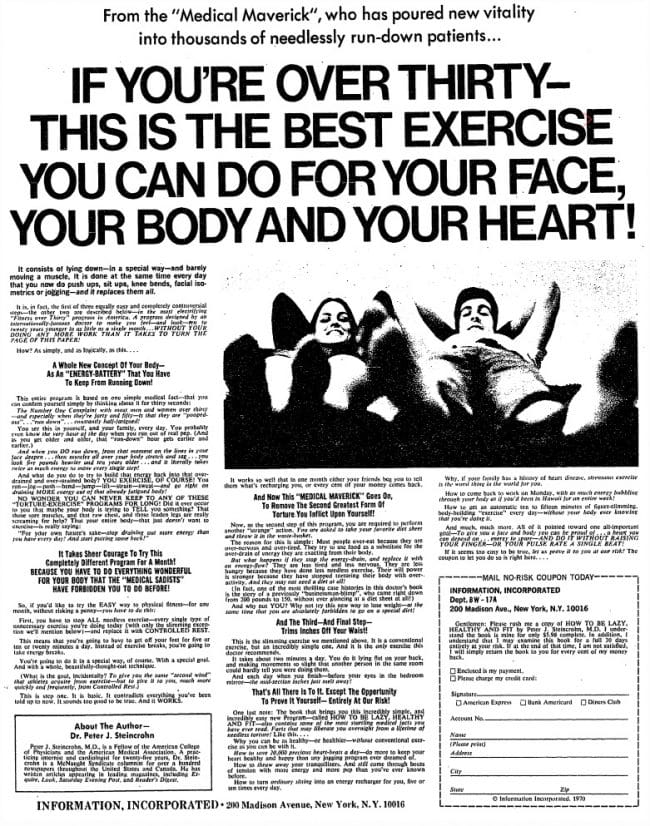 Source: Swiped.co
Source: Swiped.co
The headline makes you want to know what the exercise is, while the body copy teases and tantalizes without telling you the answer. To find that out, you have to send away for the book.
These ads are designed to boost sales or trials by creating a sense of urgency. They’re generally limited-time offers like flash sales and coupons.
Here’s a great Facebook Ad promoting a limited-time offer for a free trial:
 If you’re interested in fitness, health, or interval training and you live in the area, the chances are you’re going to take it.
If you’re interested in fitness, health, or interval training and you live in the area, the chances are you’re going to take it.
Remember Domino’s Pizza’s “You get fresh, hot pizza delivered to your door in 30 minutes or less, or it’s free” offer?
It’s one of the most famous differentiating campaigns of all time and epitomizes the purpose of differentiating ads: to build on the brand relationship. It’s the perfect way to illustrate your brand promise and establish what makes your product or service different from that of your competitors.
Finally, Weltman talks about the type of ad that makes people feel like they’re part of an exclusive club. They embrace the shared values and attitudes between consumer and brand, demonstrating to target customers that the business gets them.
Brands like Nike tend to nail this type of advertising:
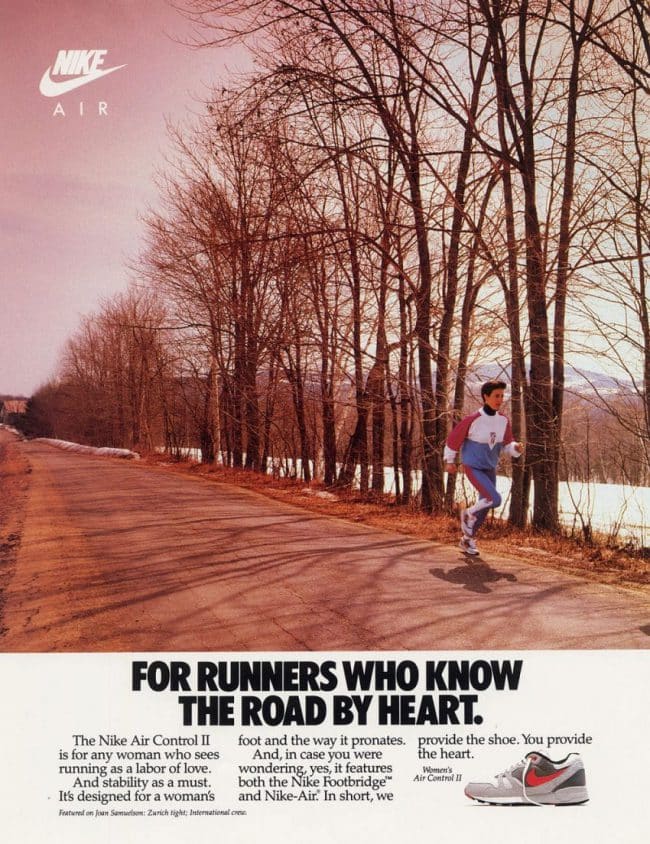 Source: Nike
Source: Nike
In the next few blog posts I’ll dig into these ad types on a deeper level and show you how to create similar ad campaigns for your own business. For now, it’s important to start considering how Facebook Ads can help you crack the organic reach problem and bring you so much more than just exposure.
If you want to jump in, start by creating an ad from a Page post using Engagement as the objective. Besides generating actions like clicks, follows, and likes, anyone sharing your promoted post with their friends will help contribute to additional organic reach.
Need help setting up and running Facebook campaigns? Download my free step-by-step guide for creating paid Facebook Ad campaigns.
 Hacking the News Feed algorithm simply means giving Facebook what it wants. The problem isn’t going away, so it’s time to start adapting your strategy if you haven’t already. Understanding how Ranking works and how you can make it work for you is a great start, but keep in mind that you’ll need a two-pronged strategy that incorporates both paid and unpaid methods for the best result.
Hacking the News Feed algorithm simply means giving Facebook what it wants. The problem isn’t going away, so it’s time to start adapting your strategy if you haven’t already. Understanding how Ranking works and how you can make it work for you is a great start, but keep in mind that you’ll need a two-pronged strategy that incorporates both paid and unpaid methods for the best result.
In addition, you should consider that content that performs well organically on Facebook might also perform just as well on other platforms. As a post ages and reach declines, many people view the content as lost. However, if you have the budget and bandwidth to repurpose your Facebook posts, you could potentially squeeze additional benefit out of it.
On a final note, Facebook owns Instagram. Organic reach has been dropping there, too, so it’s likely this trend will continue. Prepare, prepare, prepare.
What are you doing to combat the Facebook organic reach problem? Share your thoughts, stories, and tips with us in the comment section below.
